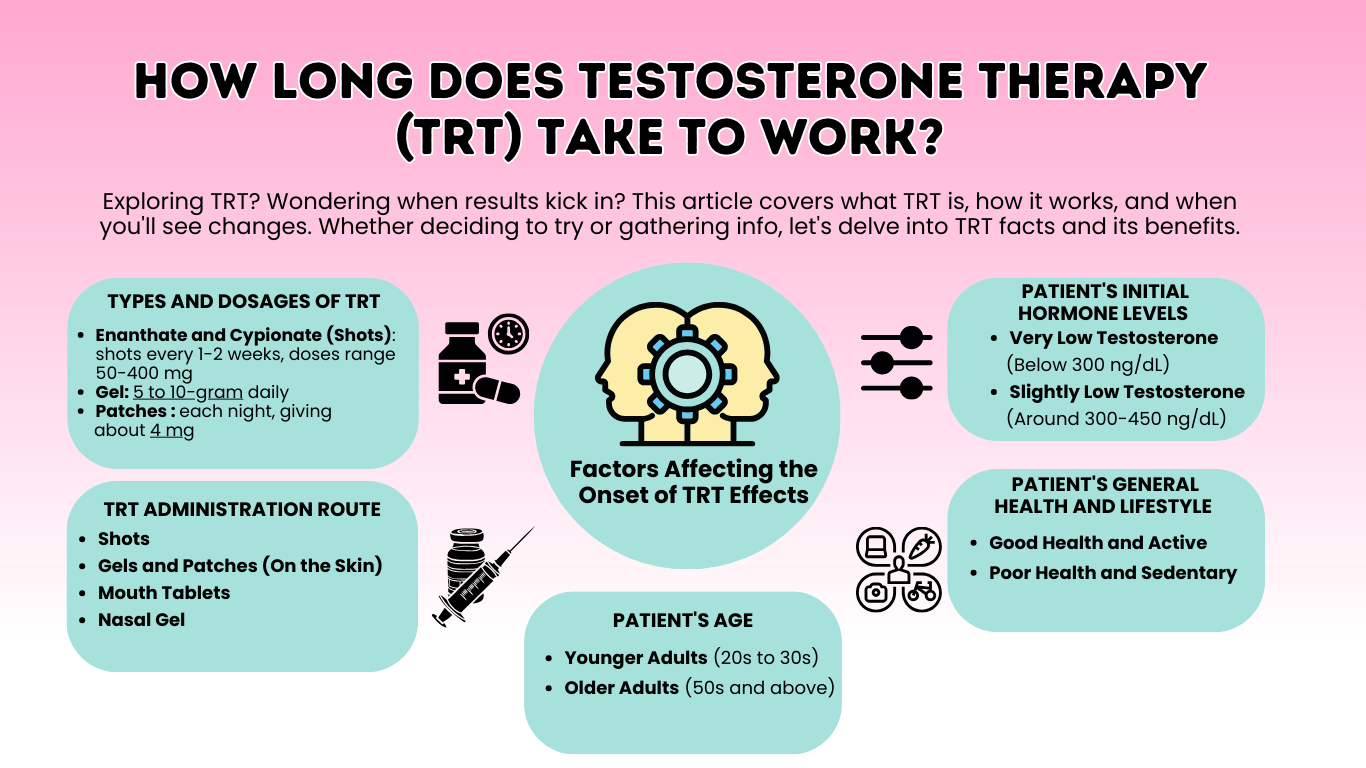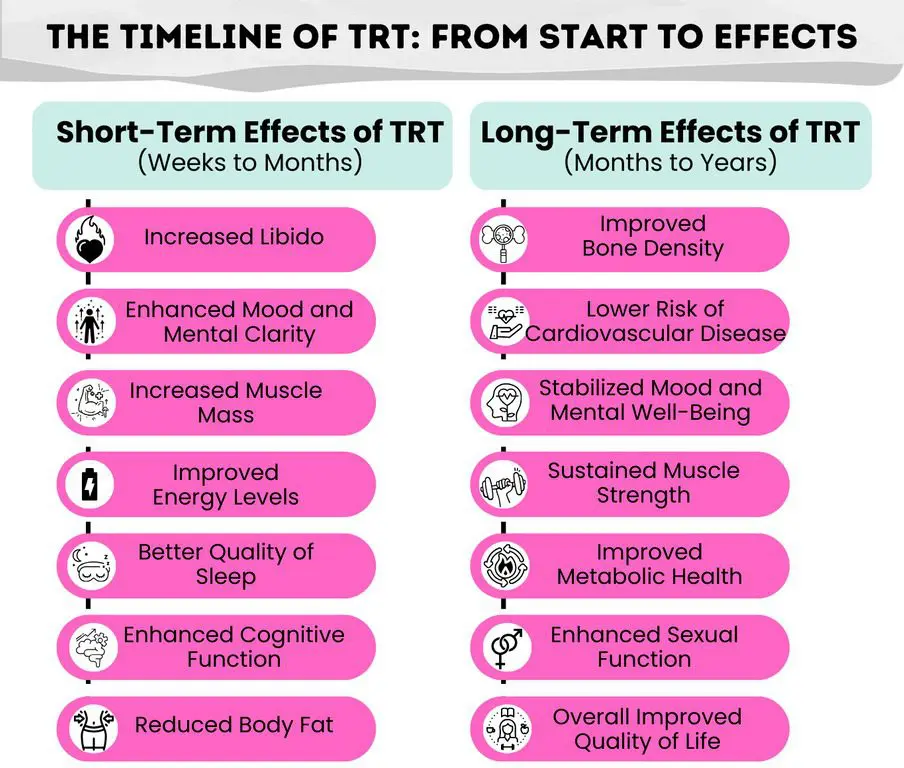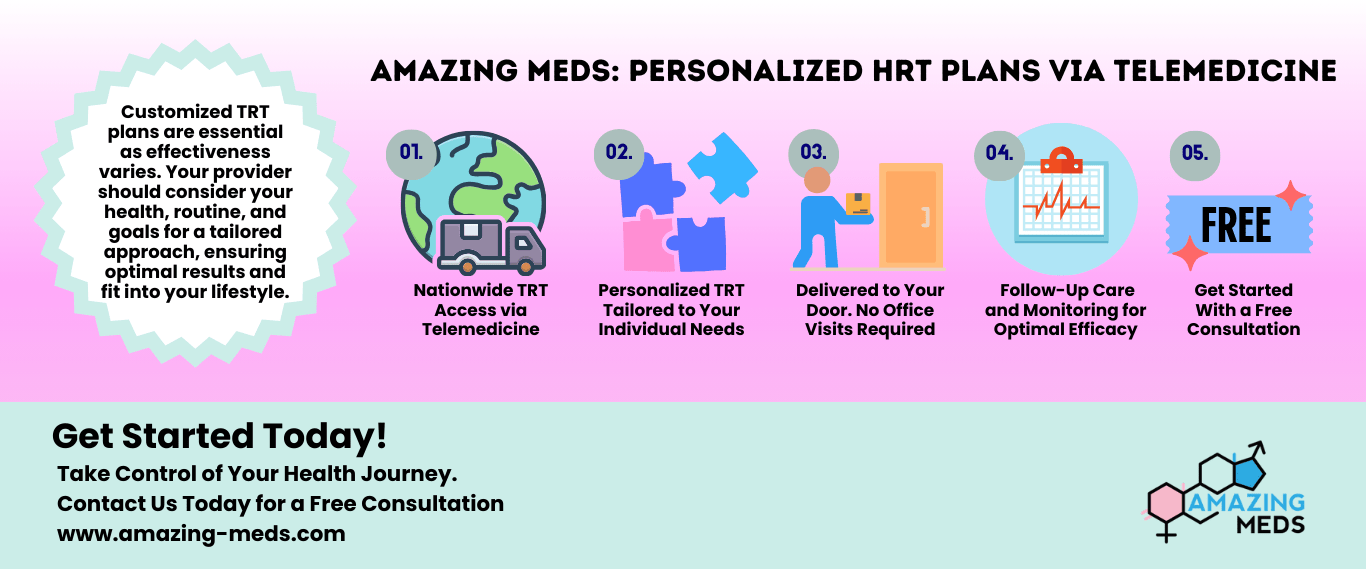Are you considering Testosterone Replacement Therapy (TRT) or just curious about it? If so, you’re likely asking yourself a very personal and significant question: “How soon can I expect to see results from TRT?” This question resonates with many people.
This guide will explain what TRT is, how it works, and most importantly, how long it usually takes to start noticing changes. Whether you’re deciding whether to try it or just gathering information, let’s explore the facts about TRT and what it can do for you.
Factors Affecting the Onset of TRT Effects
The way Testosterone Replacement Therapy (TRT) works can be different for everyone. This is because several factors play a role:
1. Types and Dosages of TRT
- Testosterone Enanthate and Cypionate (Shots): Usually given as shots every 1-2 weeks, with amounts ranging from 50 to 400 mg. Larger doses work faster but have more side effects. These shots quickly boost testosterone but can cause ups and downs in hormone levels.
- Testosterone Gel: Rubbed on the skin daily in 5 to 10-gram amounts for a steady hormone level. Good for those who don’t want shots, but if the skin contacts others it can spread to them so be careful.
- Testosterone Patches: Placed on the skin each night, giving about 4 mg of testosterone for consistent hormone levels. A good choice if you prefer not to have shots. However, patches can be hard to regulate because they give a large dose and then go down over time.
2. Route of Administration of TRT
- Shots: Quick increase in hormone levels, but you need them often. Best for quick results.
- Gels and Patches (On the Skin): These give a more even level of hormones over time, but start working slower. They’re best for steady, ongoing treatment.
- Mouth Tablets: Stick to your gums, giving a steady dose and skipping the liver. A good mix of easy use and steady hormones. Troches
- Nasal Gel: Absorbs fast through the nose for a quick but brief boost. Ideal for fast effects without shots.
3. Patient’s Initial Hormone Levels
- Very Low Testosterone (Below 300 ng/dL)
When your testosterone levels are well below 300 ng/dL, you may notice quicker and more obvious improvements. These can include increased energy, improved mood, and a stronger sex drive. In some cases, these changes can become noticeable within just a few weeks of starting TRT.
- Slightly Low Testosterone (Around 300-450 ng/dL)
If your testosterone levels are around 300-350 ng/dL, which is at the lower end of the normal range, the changes you experience might be more subtle. You may still see improvements, but they could be less dramatic and take longer to become noticeable.
4. Patient’s General Health and Lifestyle
The speed and effectiveness of TRT can also depend on your overall health and lifestyle. Here’s how:
- Good Health and Active Lifestyle
If you’re generally healthy and lead an active life, you may experience quicker and more effective results with TRT. Regular exercise and a balanced diet can help your body respond better to this treatment.
- Poor Health and Sedentary Lifestyle
On the other hand, if you have health issues or a less active lifestyle, you might notice slower improvements. Conditions like obesity, diabetes, or heart problems can impact how well and how quickly your body responds to TRT.
5. Patient’s Age
- Younger Adults (20s to 30s): With a more active metabolism, younger adults usually feel TRT’s effects faster. They might see a boost in energy, a better mood, and physical changes quicker, often within weeks.
- Older Adults (50s and above): They tend to feel changes more slowly. This is because as we age, testosterone production naturally decreases and our metabolism slows down. So, improvements in energy, mood, and physical strength might not be noticed as quickly, often taking several months to become noticeable
The Timeline of TRT: From Start to Effects
Disclaimer: It’s important to know that TRT can affect people differently. Your health, the type of TRT you use, and how you live your life can all make a difference. So, before you start TRT, talk to a healthcare provider. They’ll help you understand the good and bad sides of TRT, and give you advice based on your own situation.
Short-Term Effects of TRT (Weeks to Months)
- Increased Libido: Within 3-6 weeks, you may notice a significant rise in your sexual interest. This is one of the initial signs that TRT is starting to work.
- Enhanced Mood and Mental Clarity: In the first month, you might experience an improvement in your mood and find that your thinking becomes clearer. This can give you a sense of well-being and enhanced focus.
- Increased Muscle Mass: After 2-3 months, you could start to see muscle growth, especially if you’re engaging in regular exercise. This can enhance your physical appearance and strength.
- Improved Energy Levels: Many people report a noticeable increase in energy levels within the first few weeks of TRT. This added energy can be beneficial for daily activities and productivity.
- Better Quality of Sleep: Around 1-2 months into TRT, you may observe improvements in your sleep patterns, leading to better rest and recovery.
- Enhanced Cognitive Function: Within just a few weeks, you may begin to notice cognitive improvements such as better memory and concentration.
- Reduced Body Fat: If you maintain a healthy diet and exercise routine, you might start to see a reduction in body fat within 3-6 months. This can be helpful for managing your weight.
Long-Term Effects of TRT (Months to Years)
- Improved Bone Density: You might notice your bones getting stronger in 6-12 months, which is good for your health.
- Lower Risk of Cardiovascular Disease: After a year of treatment, your risk of heart problems may decrease.
- Stabilized Mood and Mental Well-Being: Over time, you can feel happier and mentally sharper.
- Sustained Muscle Strength: Your muscles keep getting stronger, which improves your fitness, over 6-12 months.
- Improved Metabolic Health: Positive changes in metabolism and energy levels may happen in a few months to a year.
- Enhanced Sexual Function: Your sexual health and performance may improve gradually over several months.
- Overall Improved Quality of Life: TRT can enhance your physical, mental, and emotional well-being over time, leading to a better overall quality of life.
The Importance of an Individualized TRT Plan
In Testosterone Replacement Therapy (TRT), what works for one person may not work for another. That’s why having a TRT plan made just for you is so important. Your healthcare provider should look at your health, your daily routine, and what you want to achieve with the therapy. This personalized approach ensures that the treatment is effective and fits well into your lifestyle. Tailoring the plan to your unique needs helps in getting the best possible results from the therapy.
Amazing Meds: Personalized HRT Plans Via Telemedicine
1. Nationwide TRT Access via Telemedicine
At Amazing Meds, we offer nationwide access to Testosterone Replacement Therapy (TRT) through our convenient telemedicine platform. Wherever you are in the country, you can connect with our experienced medical professionals from the comfort of your own space. Say goodbye to waiting rooms and long commutes—your health is just a virtual consultation away.
2. Personalized TRT Tailored to Your Individual Needs
Your health journey is unique, and your TRT plan should be too. We believe in personalized care that takes into account your health history, lifestyle, and goals. Our customized TRT programs ensure that your treatment fits you perfectly, optimizing results and fostering a sense of ownership in your well-being.
3. Delivered to Your Door. No Office Visits Required
We understand that your time is valuable. That’s why we simplify the TRT process by delivering your medication directly to your doorstep. No more frequent office visits or scheduling hassles. With our convenient delivery service, you can focus on what truly matters.
4. Follow-Up Care and Monitoring for Optimal Efficacy
Our commitment to your well-being doesn’t stop after the initial prescription. We provide continuous care and monitoring to ensure that your TRT is safe and effective. Regular check-ins allow us to track your progress, address emerging concerns, and make real-time adjustments to your treatment plan.
5. Get Started Today
Curious about TRT and its potential benefits for you? Take the first step and contact Amazing Meds.
Our goal is to be your trusted source of knowledge, guiding you in making informed decisions about your health. There’s no cost and no commitment—just the opportunity to explore how TRT can align with your health and wellness goals.
At Amazing Meds, we’re dedicated to providing you with personalized TRT plans that prioritize your well-being and convenience. Your health is our focus, and we’re here to support you at every step of your TRT journey.
Frequently Asked Questions
How Long Does It Take for TRT to Work?
The time it takes for TRT to work varies. Some feel better in a few weeks to a couple of months, while others may take several months to even a few years. Everyone’s journey is unique, so patience is important. Stay in touch with your healthcare provider to track your progress.
Does Age Affect How Quickly TRT Works?
Yes, age can make a difference. Younger adults often feel changes faster, within weeks, due to their active metabolism. Older adults may take longer, sometimes several months, because their natural testosterone decreases with age.
Are There Any Signs That TRT Might Not Be Working as Intended?
Absolutely, if you don’t feel the expected improvements in energy, mood, or overall well-being, talk to your healthcare provider. They can adjust your treatment plan to better fit your needs.
How Long Should I Stay on TRT?
The duration varies for each person. Your healthcare provider will consider your health and goals. Regular discussions with them will ensure you’re on the right track.
What Happens If I Stop TRT?
Stopping TRT suddenly can cause hormone imbalances and symptoms to return. Your provider will create a plan to gradually reduce your dosage when you’re ready to stop.
How Long Does TRT Take to Work – A Visual Guide
References
- Rivas AM, Mulkey Z, Lado-Abeal J, Yarbrough S. Diagnosing and managing low serum testosterone. Proc (Bayl Univ Med Cent). 2014 Oct;27(4):321-4. doi: 10.1080/08998280.2014.11929145. PMID: 25484498; PMCID: PMC4255853.
- Dobs AS, Campbell KJ. An Individualized Approach to Managing Testosterone Therapy in the Primary Care Setting. Int J Gen Med. 2022 Oct 7;15:7719-7733. doi: 10.2147/IJGM.S364189. PMID: 36238539; PMCID: PMC9552794.






